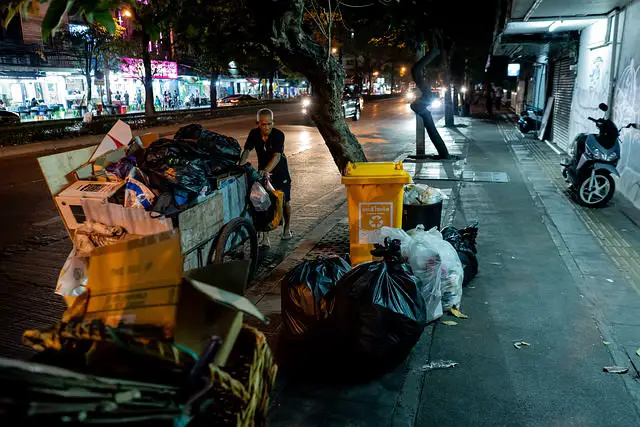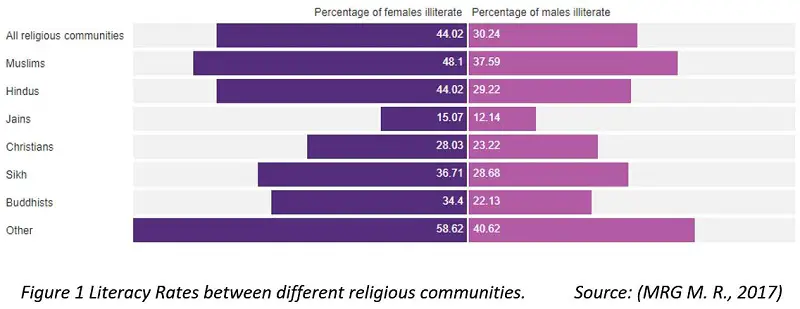Background on religious minorities in India:
“The claim of a country’s’ civilization depends upon the treatment to the minorities” -Mahatma Gandhi.
At one time or the other, we all must have heard or thought of the notion of an equal and peaceful society. What exactly this ‘equal society’ holds out to be is an important issue. The concept of an equal society is an open and unrestricted phenomenon but when we are made aware of the dark reality when the curtain rises above, we then conclude that there is no such society based on the concept of “perfect equality”. It does not mean that every society has the same straight-jacket formula to follow; it simply means that every society has a different and unique system of rating and ranking among its members of the community which is based on certain criteria. This may take the shape of different forms, which vary in social, gender, political, and economic status. Indian history makes the people around the globe aware that it’s the caste system that ranks the individual or groups from high to low and therefore leads to the formation of the hierarchy of class among the community. If we turn the pages of our life towards the history of human civilization, the fact becomes evident that the people in the past have practiced some form of classification, which took the form of social or group sorting such as lords and serfs, landlords and labourers, higher and lower caste. But, in this ostensibly modern society, we find that this concept is not limited to only the past, but also holds still holds the same position in today’s era. (Udogu, 2012)Consequently, with the flow of time, society saw the formation of social stratification where structured inequality is based on select criteria and which limits access to services and freedom that are practiced by the majority.
Related Article: Planning and Informality in India by Avnika Nagar
When India attained Independence, The Constitution of India urged in the building of an inclusive and secular society where every religion in India will respect their distinct identity, honour each other and also equitably integrate its religious minorities. But even after seventy years of being independent, India still has no law against discrimination in housing, and now, the situation is such that it has taken various forms like discrimination in terms of gender, caste, religion, and even their socio-economic background. (Sahoo, 2016)The largest minority community in India are the Muslims, who constitute around 14.2% of the country’s total population or an estimate of around 172 million people. These groups of people are mostly excluded from society and experience continuous segregation. To what extent is this biasness lawful? Who gives assent for this type of segregation to take place? There are several questions these people keep searching for answers to. According to the Census 2011, the highest number of illiterates are Muslims, who are 43% of the total population. Whereas the Jains, who only constitute 0.4% of the total population contain 86% literate. The illiteracy rate among the Muslims is allegedly the highest illiteracy rate for any single religious community in our country. (MRG, 2017)

Current Dynamics of spatial discrimination in Indian cities:
They are generally profiled as terrorists and they have to live in racial isolation. Apart from this, facing day to day discrimination in housing, education, employment, public services, etc is quite common. Over the years, we have witnessed the development of different attitudes and actions due to the biased and unfair behavior towards them. So, these people generally prefer to live in Muslim neighbourhoods where they feel that a sense of brotherhood and equality is present in terms of facilities. There they can sense what it feels like to be at home; otherwise, they are treated in a very disgusting manner by all the different religious groups. (Times T. E., 2017) Their treatment can be somewhat related to the untouchables in the earlier days. It is really sad to have to see such hypocrisy still present in a country that nurtures so many different diverse cultures. Taking an example of the scenario, a resident of a housing community alleged that “no matter what you do, people in this society will not sell their property to Muslims. We don’t bother to entertain them, even at higher rates. Moreover, even if some people have no objection to renting or selling their flats to a Muslim family, they have to face a lot of social pressure from their peer groups. (Times, 2017) It is not because people hate Muslims but, because they are afraid of the fact that if they give rent to them, the prices of the house might decrease in the near future.”
Some places in Bhopal are notorious for their “vegetarians-only” apartment buildings, which means only the upper-caste Hindus, or the members of the affluent Jain minority, can live there. While the Muslim families or the meat-eating lower-caste Hindus are generally not entertained in those areas and are more concentrated in the old city of Bhopal. The upper-class Muslims however find themselves located towards the Idgah hills. In many middle-class Bhopal neighborhoods, where single-family bungalows of the Hindu community are sold out and the developers built four or five-story apartment buildings in their property, Muslims face extreme difficulties when renting or buying flats. Many of the new large apartment complexes sprouting on Bhopal have shrines with Hindu idols and temples inside the complex, softly discouraging prospective Muslim tenants or buyers with a long history of lethal communal violence. The most common example in the city can be taken of M P Nagar, Bhopal. This area is predominantly occupied by the Hindus. They feel uncomfortable in giving the flats in the area on rent or sell them to a Muslim family. Similar is the case with Kazi Camp, an area in Old Bhopal which is occupied by mostly the Muslims. Hindus feel uncomfortable entering their society. This is not due to only one reason, there are many reasons, one of such being the market shops in the area, which you can find open till late at night. This is nothing else, but the segregation of the neighborhood in the city itself. And this is not something which should happen. India calls itself secular but at the same time selfishly acts intolerant towards its Muslim population. Is this the secularity that prevails?
Housing Biasness towards religious minorities turning Indian Cities Into Ghettos:
Due to the racial segregation in Indian cities, the Muslim community is mostly condemned to experience a social environment where poverty and joblessness are the two prevailing norms. A world for them where educational failure stands while social and physical deterioration runs amuck. Poverty is spatially concentrated creating a disadvantaged environment. In the cosmopolitan cities, the developers sell their flat only to those people, who belong to a particular religion or caste.
Nobody should have the right to deny any person, irrespective of any caste or religion, from purchasing a house in an urban space citing merely such petty reasons. Many such cases have been reported across the city and such acts are held as unconstitutional. Because of the insistence on vegetarianism, people from many communities are deprived of their fundamental right to purchase property in the country. The beef ban scenario has been an added example in the form of growing hypocrisy in the form of immature intolerance. There is a different kind of racism happening in the city, with developers denying entry to a particular community in their constructions. Urban neighbourhoods are dynamic and are constantly changing. High rates of the residential turnover characteristic of Indian cities and their well-being are dependent to a great extent on the characteristics and actions of the residents. Decisions are taken by one actor affect the subsequent decisions of others in the neighborhood and the isolated decisions and actions affect the well-being of a particular community. Taking foul actions would alter the stability of the lives of everyone in the neighborhood, Muslim or Hindu. Indian owners and landlords’ informal rules and segregation to exclude religious minorities and individuals destroing the culturally diverse character of India’s cities and separate communities into ghettosThe isolation of the minority’s community is increasing day by day rather than decreasing. As a result , the cities are becoming more and more ghettoized, weakening our social structure and further polarizing us.
Related Article: The Paradox of Urbanization
The most personal and private space of any individual is his/her house and community, everybody has a right to live in an environment or a house they choose to live. However, questions still arise in the minds of the residents of the cities taking into account the disparities occurring in the society towards the minorities and between different communities. “Do we expect strictly pacifist Jains to live next to a Muslim who slaughters animals at home and cooks meat daily, stinking up the whole place with the stench of meat?”
“Do we expect people from the orthodox Muslim community to live in proximity to riotous Christians who dance and drink and enjoy music during Christmas?” “Do we expect Hindus to live in an apartment where Muslim families hold loud prayers five times a day including at 5 am every day?”
We tirelessly try to change others but we cannot ever stop to change ourselves. Our goal is so much towards getting a non-vegetarian to turn veg like as if his/her actions really and honestly stain us. It’s the thought, and the immature sense to let it bother that is the real botheration. There are flaws in every religion, and every custom so it is futile to blame one of them.
Having the right to choose who we lease our house to and who we don’t is also our right and the government has no right to tell us and consequently our neighbours that they must welcome X or Y into their community regardless of the disruption and costs associated with it. Also apart from that it is not our right to judge who is what depending on their religion or customs.
Author Bio: Namrata Ghosh, an Urban and Regional Planner pursued masters from SPA, Bhopal currently working as a Junior Research Fellow in the Department of Architecture and Regional Planning, IIT Kharagpur. With the experience in the field of planning in both academics and professions, she has to engage in traveling and meeting new individuals and pens down the experiences about the urban and regional dynamics.
References
- MRG, M. R. (2017). A Narrowing Space: Violence and discrimination against India’s religious minorities. Minority Rights Group International.
- MRG, M. R. (2017, June). World Directory of Minorities and Indigenous Peoples. Retrieved from Minority Rights Group International: https://minorityrights.org/country/india/
- Sahoo, N. (2016, May 05). India’s Urbanisation is Dangerously Exclusionary and Unequal. Retrieved from The Wire: https://thewire.in/urban/indias-urbanisation-is-dangerously-exclusionary-and-unequal
- Times, H. (2017, January 24). No Muslims, no single women: Housing bias turning Indian cities into ghettos. Retrieved from Hindustan Times: https://www.hindustantimes.com/india-news/no-muslims-no-single-women-housing-bias-turning-indian-cities-into-ghettos/story-ZC9QyX93C9dIBbpz9BXSdL.html
- Times, T. E. (2017, February 09). Religious minorities, Dalits face discrimination in India: Report. Retrieved from The Economic Times: https://economictimes.indiatimes.com/news/politics-and-nation/religious-minorities-dalits-face-discrimination-in-india-report/articleshow/57055700.cms
- Udogu, S. G. (2012). Human Rights Issues Of Minorities in Contemporary India: A Concise Analysis. Journal of Third World Studies, Vol. XXIX, No. 1, 203-230.